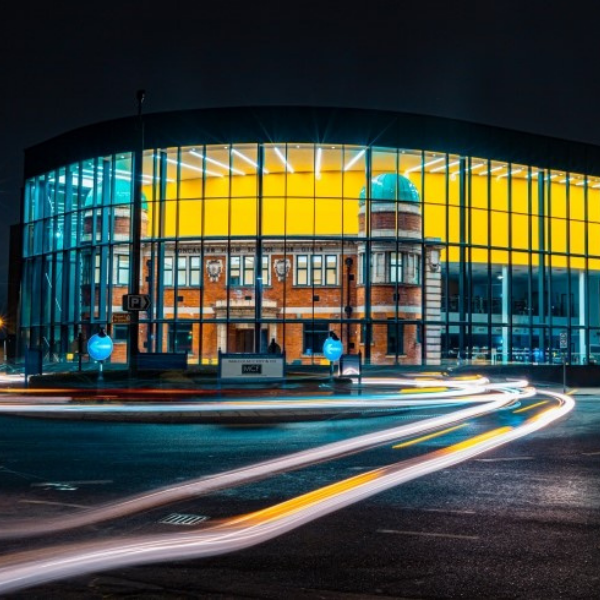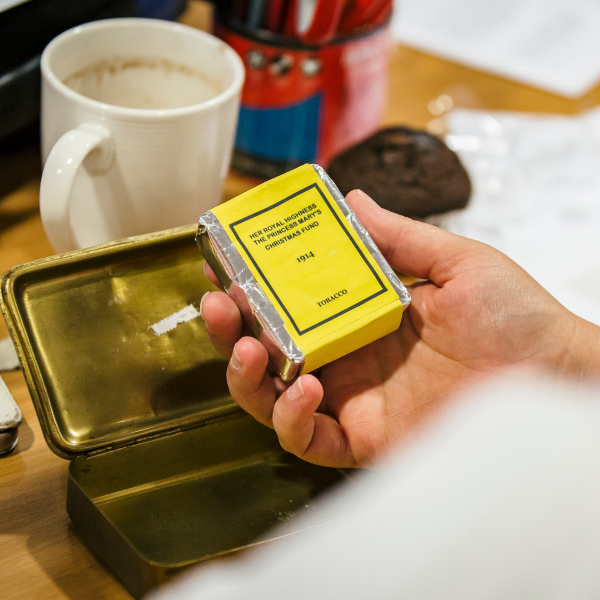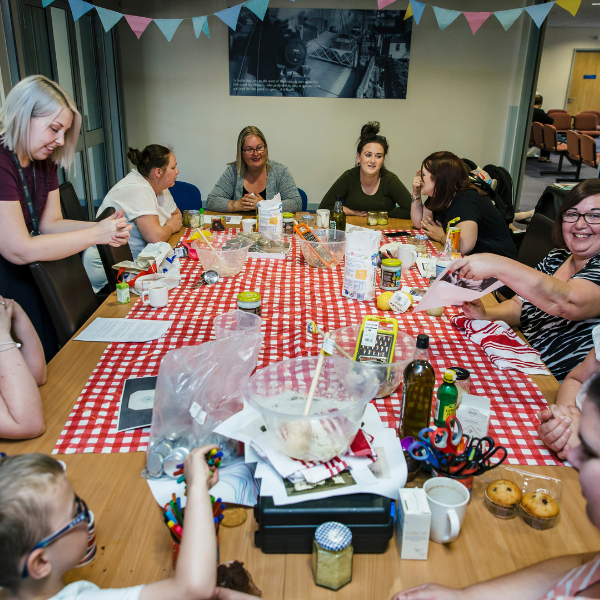Although many of us end formal education in our late teens or early twenties, it’s safe to say we all continue to learn as we go through our lives. Museums and galleries are some of the best positioned organisations in society to encourage and facilitate this lifelong learning; by utilizing the myriad of objects and stories in their respective collections and spaces. In doing this, they can offer opportunities to help post-16 and adult learners explore the world around them, engage with their communities and help give an insight into their own heritage.
Engagement with history, heritage, arts and culture is also becoming widely accepted as beneficial to our mental health and general wellbeing. For some time now, research has been undertaken to explore how this engagement can improve the quality of life of those experiencing isolation, those struggling with mental illness and those struggling with their physical health. According to Arts Council England, a recent arts on prescription project delivered by the charity Artlift resulted in a decrease of 37% in GP (General Practitioner) visits and a 39% reduction in hospital admissions.
The use of lifelong learning as a tool for both learning and wellbeing is therefore one that can reap massive benefits to the audiences and communities of museums and galleries. Nowhere else is this more prominent than in the ‘History, Health and Happiness’ programme run by Heritage Doncaster. Victoria Ryves, Programme Manager at the organisation kindly sat down with me to explain some of the outreach and community engagement work that she and her team carry out as part of this programme; with the aim of encouraging lifelong learning and fostering wellbeing in their communities.
Heritage Doncaster and Danum Gallery, Library and Museum
Heritage Doncaster is a local authority run group of history organisations in Doncaster, including the Danum Gallery, Library and Museum, Cusworth Hall, Museum and Park, King’s Own Yorkshire Light Infantry Museum and the Doncaster Archives & Local Studies Library. Situated in the heart of Doncaster, The Danum has recently undergone a major redevelopment unveiled in May 2021 and comprises an old girls grammar school, encased in a modern glass building.

The Danum Gallery, Library and Museum (Image courtesy of Doncaster Council)
The collection at Heritage Doncaster
Heritage Doncaster is home to an array of collections that enable the delivery of dynamic activities and projects within the ‘History, Health and Happiness’ programme. The original Doncaster Museum was founded as a natural history museum, which means the service holds an extensive collection of taxidermy and objects pertaining to entomology. The institution also holds a social history collection consisting of objects relating to the history of mining in the local area, as well as other objects telling the story of daily life in Yorkshire. It’s also home to a small world cultures collection made up of artefacts donated by local people who have travelled the world. Other collections include a military collection, a costume collection, and an impressive collection of art and ceramics. In the words of Victoria, “this breadth of collections are really impressive and it means that we can deliver really varied programming.”

A replica pack of tobacco given to soldiers during the First World War, used for handling in an outreach session (Image courtesy of James Mulkeen)
The History, Health and Happiness Programme
Running since the end of 2018, ‘History, Health and Happiness’ is the overarching programme that encompasses the range of projects that are managed and delivered by Victoria, her team, and her partners. According to Victoria:
“The programme aims to tackle isolation and improve wellbeing by using museum collections as the basis for outreach and community engagement activities. Our activities use history and storytelling to spark conversation, improve wellbeing and tackle isolation. Simply put, we use history to enable people to feel good about themselves, their communities and to feel more connected.”
One of the programme’s most important elements is the use of outreach as the primary vehicle for engagement. All of the activities take place outside of the museum’s spaces, in localities across the borough, such as village halls, community centres and schools. This means that the majority of the projects within the programme are carried out in collaboration with adults but there are some projects that engage families and young people. Many of these projects are delivered in partnership with other organisations and are accessed by self-referral as well as through referrals from social prescribing and other third sector organisations. A core aim of this lifelong learning is to therefore encourage engagement with local history and culture but with a particular focus on cultivating a culture of positivity and wellbeing. Victoria went on to explain that:
“what we’re doing is lifelong learning, but it also has a spin on it. It’s using learning to equip people with new skills, confidence and also to improve their wellbeing.”
As touched on earlier, the ‘History, Health and Happiness’ programme constitutes a broad array of activities, projects and clubs. These include Digital Social Clubs, Postal Activities, In-person Social Clubs, Partnership Projects, and Family Activities. For the purposes of this article, the following constitutes just some of the projects from what is an incredibly broad, varied and dynamic programme.
Herstory
One of the in-person social clubs, ‘Herstory’, brings together working-age women to discover and learn from stories of women in the past through hands-on interaction with Heritage Doncaster’s collection, crafts and activities. Meeting weekly, in the former pit village of Denaby Main, the participants are encouraged to discuss their thoughts and opinions on different historical women or women’s groups. Victoria summed up the simple, yet relaxed nature of the sessions by explaining how:
“Every week we look at a different group, or woman from history and see what we think, see whether we like them, whether we would go for a drink with them, and then do an activity in response.”
The opportunity here then is to empower local women by facilitating discussions surrounding local and national histories of women and women’s groups. Furthermore, participants can learn from each other’s histories, stories and struggles and form connections with other women in their community as well as a connection with their local area and culture.

Victoria (pictured left centre) and a group of women and their children meeting for one of the ‘Herstory’ sessions (Image courtesy of James Mulkeen)
Back 2 Nature
‘Back 2 Nature’ is one of the partnership projects within the programme. Lasting usually anywhere between eight and twelve weeks, the project is run in collaboration with Doncaster Mind and Yorkshire Wildlife Trust. Utilising the nature of the local area, participants explore historical connections to nature. For example, the final two sessions of this project focused on learning about the history of hunting and gathering by foraging at Potteric Carr Nature Reserve and learning about Norse Viking cooking culture through cooking on an open fire. The learning potential from utilising local nature and history is therefore high but so too is the potential to improve the general wellbeing of participants by interacting and socialising with each other while immersed in nature. Indeed, the connection between improved mental health and experiencing nature is not a new phenomenon. The notion of ‘connectedness’ has been used to describe how those that are able to experience nature and have a closer relationship with their natural environments and surroundings generally live happier lives.

Foraged ingredients used to make tea from one of the ‘Back 2 Nature’ sessions based on learning about the foraging of hunter gatherers (Image courtesy of Heritage Doncaster)
Changing the record
Providing opportunities for local people to contribute in some way to museum processes can be liberating for both the museum and the contributor. This is one of the aims of the ‘Changing the Record’ project. Noticing gaps of knowledge in their collection, Heritage Doncaster put a call out to recruit community researchers to help fill these areas. Importantly however, they also accepted research proposals from volunteers who had found their own gaps in the collection. Some examples include witchcraft, mental health in the Victorian period and Black history. In doing this, Heritage Doncaster provides an example of how relinquishing authority of the museum as an institution can lead to effective and more meaningful community engagement. All too often museums are in the position of authority, with members of its communities on an unequal footing. For example, one volunteer with Irish heritage suggested that Irish immigration to the Doncaster area should be explored. This wasn’t an area that the museum had thought of exploring and it would be completely feasible to assume that they may not have if it wasn’t for this volunteer. However, by allowing volunteers to take responsibility in their own area of research, utilising their own interest in and connections to history and heritage, Heritage Doncaster has provided an opportunity for mutual learning, both for themselves as an organisation but also for their volunteers and wider audiences.
Poster advertising the ‘Changing the record’ project (Image courtesy of Heritage Doncaster)
Why so much of a focus on outreach?
As all the activities take place outside of the museum walls, outreach is a central part of the programme and not without good reason. Doncaster is the largest Metropolitan Borough in England and as a result, getting to the museum can be challenging for some people. Victoria touched on this by highlighting how:
“…some of the far-reaching areas of Doncaster are approximately 45 minutes away on public transport, including a couple of changes on a bus. It’s a lot of money and if you’ve got a family of four, you’re not going to drag your kids on the bus that far. So there are practical reasons as to why we go out into the borough.”
Outreach enables Heritage Doncaster to provide a more accessible service but it also allows for an expansion of their engagement. Victoria and her team carried out statistical mapping of the borough to identify which areas had the lowest levels of cultural engagement and wellbeing, as well as the highest levels of deprivation and sickness. From this, high priority areas of the borough were identified to focus community outreach and engagement. The aim here is to engage with people who don’t necessarily believe that museums or other cultural institutions are places for themselves or their families; in turn demonstrating that in actual fact everybody does have a connection with history or heritage and should be able to access and explore this connection if they wish. While the museum may not be a place they want to visit or indeed is accessible for them to visit, Heritage Doncaster can instead bring the museum to them. After all, this is a legitimate form of engagement and just because it doesn’t manifest itself in an exhibition or a gallery tour does not mean it doesn’t qualify as such; on the contrary, the opposite could easily be argued.
Finding the sparkle again
The community engagement work within the ‘History, Health and Happiness’ programme can have a real meaningful impact on the participants’ lives. As Heritage Doncaster’s work is evaluated by Sheffield Hallam University and Arc Research and Consultancy Ltd, they are able to see that their lifelong learning work does have this impact. While data can be useful particularly for measuring effectiveness and trends, it’s those personal stories that often lead to a higher sense of satisfaction in one’s work. Victoria recalled one experience of a participant who had managed to “find her sparkle again”:
“This one lady said that at the beginning of the pandemic she was starting to ‘lose her sparkle’ but by taking part in our sessions, she had ‘found her sparkle again.’ You could hear that in her voice. She couldn’t stop talking about how pleased she was that her daughter put the Christmas decoration that she made on the Christmas tree.”
She also recalled how another participant was:
“…silent in the first session she came to, didn’t say anything and fast forward to now, where we recently took part in a radio interview where we were explaining this work and she spoke about her experiences, her mental health and how she enjoys being involved. She’s now also leading parts of the session. So she’s gone from not saying a word in the first session, to demonstrating to other participants how to do this really intricate wool weaving technique. This is just one example of how engaging in this work really does make a difference to people’s lives and it’s that kind of pinch me moment where you think, ‘this is why I do what I do, this is why the work does make a difference.’”
It seems therefore that the outreach offered within the ‘History, Health and Happiness’ programme is able to connect people not only with art and culture or history and heritage but also to the people around them. Not only this but the lifelong learning element of this work also offers the potential to develop valuable new skills, in this case, weaving, public speaking and teaching.
Taking its toll
While this community engagement can be highly rewarding for both the learner and the practitioner, it can also be draining, challenging and at times taxing on the practitioner’s own mental health. Victoria makes the point that as community engagement practitioners engaging in this line of work, “we can’t look after others if we’re not looking after ourselves.” Working regularly on establishing and maintaining relationships with vulnerable people or groups can require a considerable amount of emotional labour that is often overlooked within the sector, as this type of work often goes unrecorded. The potential for this to be detrimental to practitioners’ own mental health is therefore considerably high and necessitates that appropriate systems of care should be put in place to support them. This could include training Mental Health First Aiders within organisations, regular wellbeing check-ups with colleagues or a budget put aside to access therapy and other services which can assist in improving mental health. Victoria and some other museum colleagues from Yorkshire have recently established GLAM Cares, a care and support network for community engagement professionals within galleries, libraries, archives and museums. It’s a place for practitioners to explore and discuss how they can better look after themselves while carrying out their important but challenging work. The group will be offering networking events, training and peer support. For more information, see the links at the end of the article.
The GLAM Cares logo and slogan (Image courtesy of GLAM Cares)
Concluding thoughts
Engaging in lifelong learning work through outreach can be highly rewarding for all parties involved but offers potential risks for practitioners if appropriate provisions are not put in place. Indeed, outreach allows practitioners to operate without the confinements of the museum walls and engage with individuals and communities who have much to contribute and share but may not be able to or feel comfortable in visiting the museum in-person. Furthermore, there is massive potential to improve participants’ mental health and wellbeing as demonstrated in the individual who “found her sparkle again” through participating in her own learning and another participant taking the lead to help others around her learn. However, engaging those who may have had difficult or traumatic experiences can paradoxically take a considerable emotional toll on practitioners’ own mental health and wellbeing. It’s therefore worth noting that community engagement and outreach designed at improving the quality of life of those in areas of high deprivation and with poor mental health can be a double-edged sword; providing an opportunity to help enrich the lives of the participants but with the possibility that it may be of detriment to the practitioners involved. Nonetheless, if appropriate support systems are put in place, then there’s no reason as to why outreach and community engagement work focused on supporting wellbeing and improving mental health couldn’t, nor indeed shouldn’t, become more commonplace for the museum of the twenty-first century.
A special thank you to Victoria Ryves for providing the research that went into creating this article. In order to refine the scope of this article, the above has only touched on just some of the work herself and her team do as part of the ‘History, Health and Happiness’ programme. If you would like to know more about the programme you can get in touch with Victoria at: victoria.ryves@doncaster.gov.uk
Useful links:
- Arts Council England, ‘What can culture do for healthcare?’: https://www.artscouncil.org.uk/blog/what-can-culture-do-healthcare-0
- Artlift: https://artlift.org/
- Heritage Doncaster: https://www.heritagedoncaster.org.uk/
- Danum Gallery, Library and Museum: https://www.dglam.org.uk/
- Cusworth Hall, Museum and Park: https://www.heritagedoncaster.org.uk/cusworth-hall/
- King’s Own Yorkshire Light Infantry Museum: https://www.dglam.org.uk/koyli/
- Doncaster Archives & Local Studies Library: https://www.heritagedoncaster.org.uk/archives-local-studies/
- History, Health and Happiness: https://www.heritagedoncaster.org.uk/projects/happyhistory/
- Doncaster Mind: https://www.doncastermind.org.uk/
- Yorkshire Wildlife Trust: https://www.ywt.org.uk/
- Potteric Carr Nature Reserve: https://www.ywt.org.uk/potteric-carr
- GLAM Cares: https://twitter.com/glam_cares
A question for you…
What steps do you think could be taken to better care for professionals and practitioners engaging in challenging community engagement work?
Feel free to answer in the comment box below.

